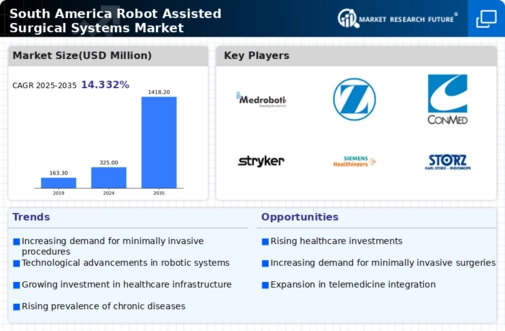Patient-Centric Healthcare Trends
The shift towards patient-centric healthcare is significantly impacting the robot assisted-surgical-systems market. In South America, there is a growing emphasis on tailoring medical treatments to individual patient needs, which aligns well with the capabilities of robotic surgical systems. These systems allow for minimally invasive procedures that can be customized based on patient anatomy and specific health conditions. As a result, hospitals are increasingly investing in robotic technologies to meet the rising expectations of patients for personalized care. The robot assisted-surgical-systems market is thus likely to see a surge in demand as healthcare providers strive to enhance patient experiences and outcomes through advanced surgical options.
Government Initiatives and Funding
Government initiatives aimed at improving healthcare infrastructure in South America are significantly influencing the robot assisted-surgical-systems market. Various countries in the region are allocating funds to modernize hospitals and integrate advanced technologies, including robotic surgical systems. For instance, recent reports indicate that public health budgets have increased by 10% in several South American nations, with a portion earmarked specifically for technological upgrades. These initiatives not only enhance the capabilities of healthcare facilities but also encourage private investments in the robot assisted-surgical-systems market. As government support continues, it is expected that the adoption of robotic systems will accelerate, leading to improved surgical outcomes and patient satisfaction.
Rising Demand for Precision Surgery
The increasing demand for precision in surgical procedures is a notable driver in the robot assisted-surgical-systems market. Surgeons and healthcare providers in South America are increasingly recognizing the benefits of robotic systems, which offer enhanced accuracy and reduced variability in surgical outcomes. This trend is reflected in the growing number of hospitals adopting robotic systems, with a reported increase of approximately 15% in installations over the past year. As patients become more informed about their surgical options, the preference for procedures that utilize robotic assistance is likely to rise, further propelling the market. The robot assisted-surgical-systems market is thus positioned to benefit from this shift towards precision, as it aligns with the broader healthcare goal of improving patient outcomes.
Growing Awareness of Robotic Surgery Benefits
The growing awareness among healthcare professionals and patients regarding the benefits of robotic surgery is a crucial driver for the robot assisted-surgical-systems market. Educational campaigns and professional training programs have been instrumental in disseminating information about the advantages of robotic systems, such as shorter recovery times and reduced postoperative complications. Surveys indicate that approximately 70% of surgeons in South America are now familiar with robotic-assisted techniques, a significant increase from previous years. This heightened awareness is likely to translate into increased demand for robotic systems in surgical settings, thereby enhancing the robot assisted-surgical-systems market. As more practitioners advocate for these technologies, the market is poised for substantial growth.
Technological Integration in Surgical Practices
The integration of advanced technologies, such as artificial intelligence and machine learning, into surgical practices is emerging as a key driver in the robot assisted-surgical-systems market. In South America, hospitals are increasingly adopting these technologies to enhance the capabilities of robotic systems, leading to improved surgical precision and efficiency. Reports suggest that the incorporation of AI in surgical robotics could potentially reduce operation times by up to 20%, thereby increasing the throughput of surgical procedures. This trend indicates a shift towards more sophisticated surgical environments, where the robot assisted-surgical-systems market is likely to thrive. As technology continues to evolve, the demand for integrated robotic systems is expected to grow, further solidifying their role in modern surgery.

















Leave a Comment